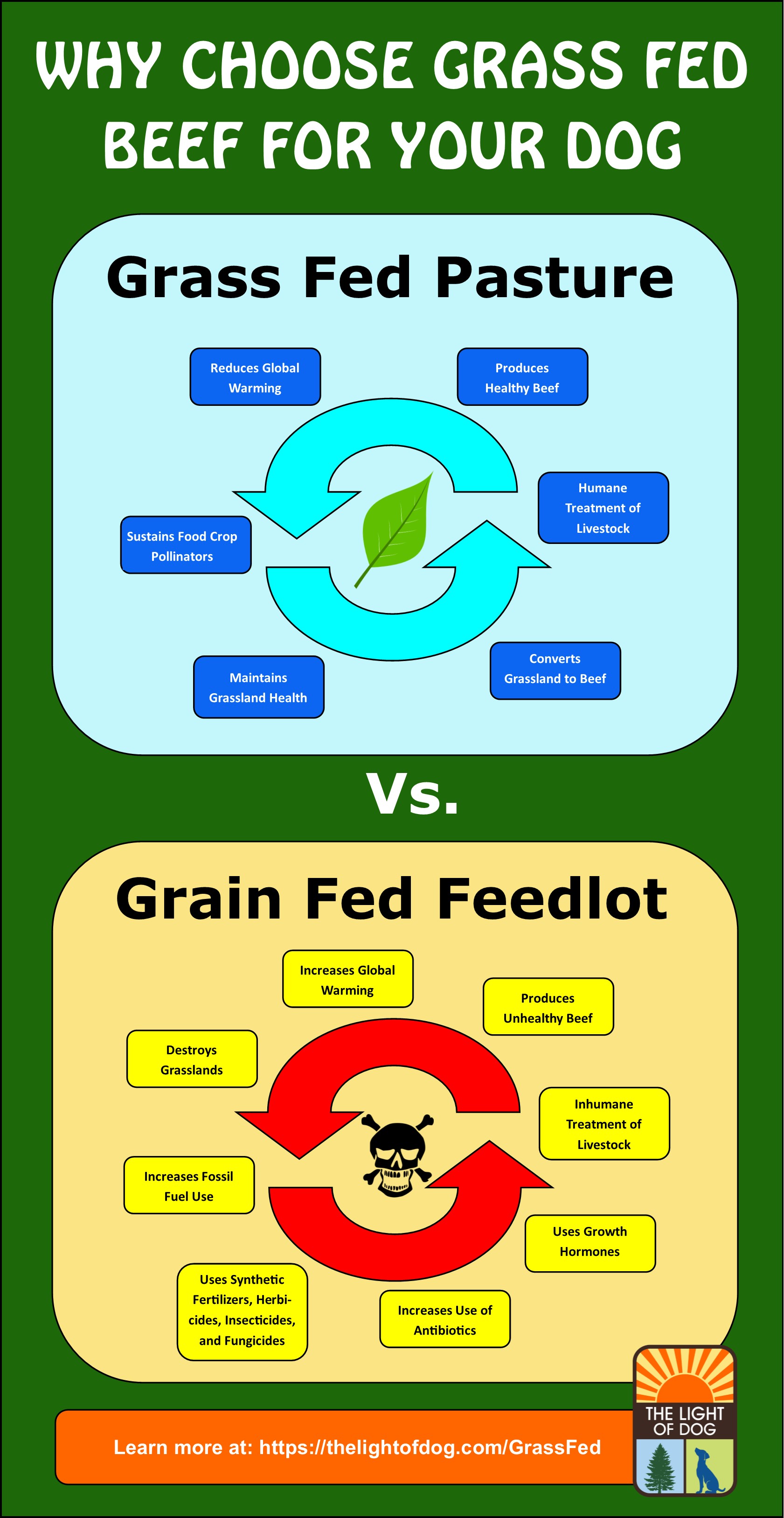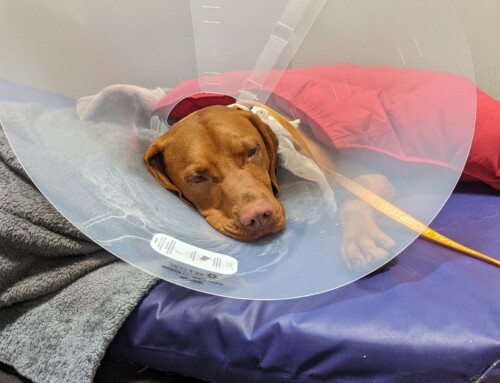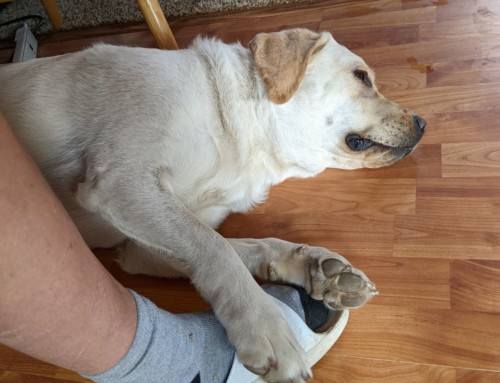DOG TRAINING OFFERED IN-PERSON AND ONLINEOur dog training services are delivered in almost any format that meets your needs. We have GROUP CLASSES at our indoor and outdoor facilities on our farm, ONLINE LIVE STREAMING classes, and SELF-PACED VIDEO-BASED training through our Online Dog Training Course. Our PRIVATE TRAININGS can be done in-home, outside, in public dog-friendly locations, at our facility on our farm, online via phone or video conferencing and through email. |
I eat beef from 100% grass fed cows from small Colorado ranches. It's the same meat we feed our dogs. I've known for some time that the health benefits of grass fed beef are superior to grain fed.
But, until recently, I was not aware of the host of environmental and carbon benefits of grass fed beef, and the dramatic injury that grain fed feedlot beef is hoisting upon our health and environment, not to mention the even more grotesque and inhumane treatment of the livestock.
And yet, more than 94% of the beef we consume in the U.S. is grain fed feedlot beef!
What's more, even China, whose pet products many of us refuse to purchase, is refusing grain fed beef imports from the U.S. because of serious animal welfare problems associated with the beef, while the U.S. regulatory agencies do nothing.
But there's a simple fix that each one of us can do to help turn this around.
First, let's take a look at grass fed versus grain fed feedlot beef. I do my best to summarize key points in this article to keep it shorter, but include a sizeable list of information sources cited in the footnotes.
What is Grass Fed Beef, Grain Fed Beef, Grasslands and Why Feedlots?
What is Grass Fed Beef?
By definition, grass fed is a diet fed to a ruminant (beef, bison, goat, lamb and sheep), consisting of grass (annual and perennial), forbs (e.g., legumes, Brassicas), browse, or cereal grain crops in the vegetative (pre-grain) state. Animals cannot be fed grain or grain byproducts and must have continuous access to pasture during the growing season (1).
If beef is labeled grass fed, it does not mean it is free of hormones or antibiotics. These need to be labeled separately. Further, ‘access' doesn't mean exclusive diet, and doesn't mandate how much actual time the herd spends outdoors. It's entirely possible to raise beef indoors on hay and still have it qualify as USDA grass fed. The only way to know is if the packaging, website or other marketing material of the product provides additional information about pasture grazing. Or, if you purchase direct from ranches, you can ask them.
Grass fed does not mean that the cow was never feed genetically engineered plants.
Cows may be grass fed for most of their lives and then grain fed for a short period of time before slaughter. If so, they cannot have the grass fed standard outlined by the USDA.
The organic designation does not mean the cow was grass fed. If the meat does not have the USDA grass fed standard, then it cannot be trusted to be from 100% grass fed cows.
A USDA grade designation of “Prime”, “Choice”, or “Select” does not mean it is grass fed. It must say grass fed beef on the label.
If the label does not have “Grass Fed”, then the beef was grain fed for at least some portion of its life.
What is Grain Fed Beef?
There is technically not a standard for grain fed beef like there is for grass fed beef. All cows are typically born and spend the first part of their lives on the pasture or grassland, eating grass and enjoying the outdoors. After a certain period of time, they will then move to a feedlot and be fed grains, which may or may not include hay. The time when they move from pasture or grassland varies from ranch to ranch. From the feedlot, they are slaughtered and turned into meat.
What are Grasslands?
Grasslands are characterized as lands dominated by grasses rather than large shrubs or trees. It is estimated that 40% of the world is covered in grasslands. Prior to settlement, it is estimated that 50% of the United States was covered in grasslands, with that number at approximately 30% at present day and predominantly in the Rocky Mountain and Midwest plain states of the country (2).
Why Are Cows Predominantly Grain Fed?
The industry switched to predominantly grain fed in feedlots after WWII to reduce costs and increase profits and reduce the price of beef to consumers. At present, best estimates indicate grass fed beef accounts for between only three and six percent of total U.S. beef sales. The remaining 94% to 97% of cattle beef sales in the U.S. are from grain fed cows.
The Positive, Self-reinforcing and Sustainable Ecology Pattern of Grass Fed Beef
Grasslands Process Carbon From the Atmosphere
Grasslands are important because they not only store carbon that would otherwise be in the atmosphere, which would contribute to global warming, but also because the growing process by grassland plants actually pull carbon out of the atmosphere (3).
Grasslands Are Very Important to Food Crop Pollination
75% of the crops we use to grow food require bees to pollinate them and globally, one-third of those pollinators live on grasslands (4).
Ruminants (Beef, Bison, Goat, Lamb and Sheep) keep Grasslands Healthy
We now know that the best way to preserve and even rehabilitate our grasslands is to let large ruminants graze on them, in ways that mimics the natural environment. In the natural environment, large herds of wild ruminants, such as Bison in the U.S. plain states prior to the 1800’s, would intensely graze an area. By consuming the grass shoots down to the base of the plant (leaving the plant and roots to re-grow), ruminants are aiding the plants by removing plant material that would end up dying off in the winter. If left to die off, the resulting standing dead plant matter would take decades to properly decompose, which hinders growth of new grassland plants and either allows woody-tap rooted plants to take over, or if the rainfall in the area is low, then desert bushes and bare soil results (6). Either of these options leads to less plant, soil and animal diversity, and in cases of bare soil, leads to wind and water erosion, stripping whatever beneficial top soil is left (7).
Ruminants grazing in large numbers in a small area stimulate biological activity in the soil by using their hooves to break the soil surface, press down seeds so that they will produce new growth, press down other dead plant matter so that the soil can decompose it, and deposit their animal waste that adds beneficial microorganisms and organic matter to the soil. When the area has been sufficiently eaten over by the ruminants, they move on, leaving that area to rest and re-grow.
We know that soil with plants in it is the best way to prevent erosion from wind and water and to capture rain for use in the soil (8). By using ruminants to graze on grasslands that mimic the natural environment, we have a very effective tool for preserving and rehabilitating our grasslands.
Ruminant’s (Beef, Bison, Goat, Lamb and Sheep) Have The Unique Ability to Digest Nutrient-poor Grass From Grasslands
Ruminants have the unique ability to convert grass from grasslands, which is largely indigestible by humans, into nutrient-dense meat. In effect, the cows are taking the raw ingredients of the sun that shines on the plants, the carbon in the soil and our atmosphere that feed the plants, and naturally occurring rainfall that water the plants, eating those plants, and producing healthy meat that we can consume, with very little assistance or interference from humans. Ruminants are uniquely created to maintain the health of our grasslands, which helps maintain the health of our atmosphere, and create nutrient-dense beef for us to consume.
Cows Grazed on Grasslands Have Happy, Healthy Lives
With sun, fresh air, room to roam, graze and socialize, that is not just the best way for ruminants to live, but also puts them to their best use for the benefit of us and our environment.
Grassland-fed Beef is Healthier Than Grain fed Beef
Studies show the grass fed beef has far more omega 3 and other healthy fatty acids, the right kind of saturated fat, and considerably more antioxidants, vitamins, and minerals, over grain-fed beef (5).
FIGURE 1
Grazing cows on grasslands gives us a positive, self-reinforcing and sustainable ecological pattern.
We know the benefits to maintaining grasslands through cattle grazing and in turn, the benefits that the grassland provides to producing nutrient dense meat, while giving the animals happy lives. Let’s look at what grain fed feedlot beef does to cattle in feedlots.
The Negative, Self-reinforcing And Destructive Ecology Pattern of Grain Fed and Feedlot Beef
Plowing Grasslands to Produce Grain For Cows Contributes to Global Warming
When grasslands are plowed for growing grain crops to feed cows, the plowing not only releases stored carbon, but the unique processes – ones which exist predominantly in soil that is not plowed – for pulling carbon from the atmosphere are largely destroyed, thereby shutting off the ability for the plowed land to pull carbon out of the atmosphere (3) (9).
Grain-feeding Burns More Fossil Fuels
Growing grain to feed cows requires equipment to plow, plant, fertilize, apply pesticides, harvest and dry crops, then transport them to the cows, run waterers and feeders for the cows, collect waste, run ventilation and flushing systems, and operate manure spreaders.
Growing Grains to Feed Livestock Requires Synthetic Fertilizers, Herbicides, Insecticides, and Fungicides
Approximately 36% of corn grown in the U.S. is fed to livestock (10) and represents over 90% of the livestock feed (11). Corn causes the most soil erosion of any crop (12), uses more herbicides and pesticides that any other crop (12), which makes it the crop that causes the most ground water and stream pollution, and it is the largest synthetic fertilizer user (13). At least one pesticide has been found in all streams studies by the U.S. Geological Survey in a decade-long study from 1992 to 2001 (14). Synthetic fertilizer also disrupts the process for pulling carbon from the atmosphere (3).
Feedlot Animals Get 80% of this Nation's Supply of Antibiotics and 75% of That Ends Up Unchanged In Our Environment To Create Antibiotic Resistance
Antibiotics are fed to feedlot animals to help minimize sickness and disease from their confined living conditions. However, it is used in such high quantities because it helps stimulate growth, thereby allowing cattle to be taken to slaughter sooner. As a result, it is fed to all feedlot animals, regardless of whether they are sick or not. What’s more, Up to 75 percent of antibiotics fed to animals will pass unchanged into animal feces and urine, entering the environment in full force and effect (15). This raises the specter of widespread effects on wildlife and humans that come in contact with the drugs in the environment and on meat. It is well established that such antibiotic use is contributing to the worldwide rise of antibiotic resistance.
Due to public health risks, the U.S. Centers for Disease Control and Prevention, World Health Organization, American Medical Association, and American Public Health Association have all taken positions against the practice of continually feeding farm animals antibiotics. Yet the feedlot and grain fed meat industry continues to use its lobbying dollars to defeat any attempts to pass legislation banning the widespread use of antibiotics.
Growth Hormones That Hurt, Not Help. Even China has banned Use of One Type, But Not the U.S.
Growth hormones are given to cattle to help them grow faster so they can be taken to market sooner. One type, in particular, has been banned by China, Russia and the EU, and some U.S. companies are starting to refuse to purchase cattle fed this particular growth hormone. Despite this increasingly widespread resistance, this type of drug continues to be administered to large numbers of U.S. feedlot cattle (18).
Inhumane Treatment of Livestock
Livestock were designed to fulfill their design of roaming grasslands and converting it to nutrient-dense meat. Confining them to feedlots prevents them from serving this purpose and exposes them to a foul-smelling environment and greater need for antibiotics to keep them healthy from confined living spaces. Further, ruminants were designed to consume grass, not grains and have greater difficulty digesting grains. This does not mean they can never consume grains, but to completely replace their diet of grass with grains in a feedlot is not healthy for them.
Feedlot Cattle Produce Much Less Healthy Meat
Studies show that feedlot cattle have far less omega 3 and other healthy fatty acids, the wrong kinds of saturated fat, and considerably fewer antioxidants, vitamins, and minerals, over grain-fed beef (5).
Feedlot Cattle fed grains have more acidic intestinal tracts, which MAY favor the growth of E.coli and acid-resistant strains of the pathogen, which is able to survive the acidic conditions of the human stomach and prove fatal (16). Studies are conflicting on this hypothesis, but it is a possibility (17). While incidences of E.coli have dropped sharply over the last 10-years, that has more to do with the level of bacteria-control in the animal slaughter process (17).
FIGURE 2
Feedlot cows give us a negative, self-reinforcing and ultimately, destructive pattern
Feedlot and grain fed beef is proving to have disastrous consequences for humans, our pets food, our environment and the health of the cattle. The only benefit it appears to be providing is to increase the profitability and revenue of the industrialized feedlot and grain fed industry.
The Simple Fix To Turn This Around
You may have already guessed it…buy 100% grass fed beef. Make sure the label says somewhere on it that it is 100% grass fed beef, with no added hormones or antibiotics and pasture raised.
Better yet, get your beef directly from ranchers. Use this website to find ones in your area.
Look for ranches that are certified by the American Grassfed Association and have at least a Step-4 or higher rating from the Global Animal Partnership. While most ranches we know about do not have these certifications, they do abide by their standards. Certification can be costly and time consuming, so look up the standards yourself and use them when talking to ranches. That is what we do for ranches we buy from which are not certified.
When you buy direct, you cut out all distributors and retailers and go direct to these ranchers who are deserving of your food dollars.
When you buy products like ours that use 100% grass fed beef, with no added hormones or antibiotics and pasture raised, your pet food dollars are not just supporting a healthy ecology pattern for our food, but you are taking away dollars from the industrialized grain fed feedlot industry.
Footnotes
1. USDA Grass Fed Marketing Claim Standards:
https://www.ams.usda.gov/AMSv1.0/ams.fetchTemplateData.do
2. Food and Agriculture Organization of the United Nations (FAO): https://www.fao.org/docrep/008/y8344e/y8344e05.htm and United States Grasslands and Related Resources: An Economic and Biological Trends Assessment
3. Hahn Niman, N. Defending Beef: The Case for Sustainable Meat Production (Chelsea Green, 2014).
Page 28: Soil sequestration takes glue, glue that literally tacks carbon to the earth, keeping it safe from washing or floating away. The sticky substance involved, a protein that under a microscope looks like strands of honey and is produced by underground fungi wrapped around plant roots, is called glomalin. [Glomalin] makes up 15 to 20 percent of soil’s organic matter [in grassland soil].
Arbuscular mycorrhizal fungi, the fungi involved in glomalin synthesis, function symbiotically with plants. Formed as networks of fine threads (hyphae), they envelop plant roots and extend their thin fingers out into soils. These fungal filaments engage in two-way exchanges: transporting nutrients from the soil to the plant while carrying carbon from the plant to the soil. Glomalin is a carbon-based molecule, while mycorrhizal fungi are carbon-based life-forms. Both utterly depend on carbon, which they obtain only from the roots of a living plant. Nichols refers to carbon as the currency in these exchanges. The plant uses carbon to “buy” nutrients from the mycorrhizal fungus. The fungus may then use that carbon to “buy” nutrients from other microorganisms in the soil.
Glomalin “glue” plays several roles in the process. It coats the fungus’s hyphal threads, assisting in nutrient cycling while also protecting them. Moreover, it aids in forming and stabilizing clumps, known as soil aggregates, helping plant health and soil structure. (Proteins left behind by earthworm locomotion may also play a role in soil aggregation, although studies are somewhat conflicting).
Formation of soil clumps may sound banal, but it is considered a cornerstone of carbon sequestration. In aggregation, soil’s mineral particles are clustered together and encapsulated. This stabilizes the carbon-containing decomposed plant and animal matter (humus), and protects it from degradation. Carbon from plant roots has been shown to be especially stable, lasting over twice as long in the soil as carbon from plant stems and leaves. Soil aggregation gets carbon into a stable situation and keeps it there.
Healthy soil is filled with these tiny clumps. Soil aggregates “provide structure to soil for better water infiltration, water holding capacity, and gas exchange, and increase soil fertility by providing organic carbon (that is, food) to soil organisms, which use this food as energy to release plant nutrients from the soil,” Nichols explains.
Ongoing field research shows that soils under native grasses in North Dakota— for example, switchgrass, blue grama, big bluestem, and Indian grass— have higher levels of glomalin than those planted with non-native grasses. This raises the intriguing possibility that restoring native grasslands could be a key component of a global climate change mitigation strategy. “The more glomalin in a particular soil, the better that soil probably is,” says [Dr. Kristine] Nichols [discovered glomalin along with Dr. Sara Wright in 1996]. And up to a certain saturation point, the more glomalin, the more potential for carbon sequestration. Correspondingly, Dr. Nichols’s research has shown that plowing ground injures the root-loving fungi and reduces glomalin.
Page 30: Nichols has learned that using synthetic fertilizers, particularly phosphorus, creates unfavorable conditions for such transactions. Phosphorus is a key nutrient used by mycorrhizal fungi in trade for carbon from the plant. When commercial fertilizer is added, the plant simply takes nutrients from the fertilizer rather than “buying” those nutrients from the fungus in exchange for carbon. Synthetic nutrients ultimately lead to debilitated mycorrhizal networks and lower levels of glomalin. Photosynthesis provides the carbon needed for mycorrhizal fungal growth and glomalin production. Without plants in the ground, the cascade of intricate processes grinds to a halt.
Page 32: Not surprisingly, converting grassland to cropland causes carbon losses, while converting cropland to grass results in carbon gains.
4. U.S. Fish and Wildlife Service data. https://www.fws.gov/ pollinators and Hahn Niman, N. “A Way to Save America’s Bees: Buy Free Range Beef.” The Atlantic (July 14, 2011). https://www.theatlantic.com/ health/ archive/ 2011/ 07/ a-way-to-save-americas-bees-buy-free-range-beef/ 241935
5. The Savory Institute: Healing the World’s Grasslands, Rangelands and Savannas. https://blogs.worldwatch.org/nourishingtheplanet/the-savory-institute-healing-the-worlds-grasslands-rangelands-and-savannas-livestock-buckminster-fuller-institute-nourishing-the-planet-worldwatch-institute-usda-climate-change-internatnional-society/
6. Animals Key to Biodiversity of Over-Fertilized Prairies. https://www.umdrightnow.umd.edu/news/animals-key-biodiversity-over-fertilized-prairies
7. Savory, A. Holistic Resource Management (Island Press, 1988)
8. Chris Kresser. “Why Grass-Fed Trumps Grain-Fed”. https://chriskresser.com/why-grass-fed-trumps-grain-fed/
Depending on the breed of cow, grass-fed beef contains between 2 and 5 times more omega-3 [fatty acids] than grain-fed beef, and the average ratio of n-6:n-3 in grass fed beef is 1.53:1. In grain fed beef, this ratio jumps all the way up to 7.65:1.
Conjugated linoleic acid (CLA) is a type of PUFA [fatty acid] that is found naturally in milk and meat products, primarily from ruminants such as cows or sheep. CLA exhibits potent antioxidant activity, and research indicates that CLA might be protective against heart disease, diabetes, and cancer. Beef is one of the best dietary sources of CLA, and grass-fed beef contains an average of 2 to 3 times more CLA than grain-fed beef
There are three main types of saturated fat found in red meat: stearic acid, palmitic acid, and myristic acid. Grass-fed beef consistently contains a higher proportion of stearic acid, which even the mainstream scientific community acknowledges does not raise blood cholesterol levels. This higher proportion of stearic acid means that grass-fed beef also contains lower proportions of palmitic and myristic acid, which are more likely to raise cholesterol.
Another reason grass-fed meat surpasses grain-fed is that it contains considerably more antioxidants, vitamins, and minerals. Carotenoids, such as beta-carotene, are precursors to vitamin A that are found as pigments in plants. Grain-fed beef does not contain appreciable levels of carotenoids, for the simple reason that grains don’t contain them. However, cows that eat carotenoid-rich grass and forage incorporate significant amounts of these compounds into their tissues. These carotenoids make the fat from grass-fed beef more yellow than the fat from grain-fed beef, so fat color can be a good indicator of how nutrient-rich your meat is.
Grass-fed beef also contains significantly more of the antioxidants vitamin E, glutathione, superoxide dismutase (SOD), and catalase than grain-fed beef. These antioxidants play an important role in protecting our cells from oxidation, especially delicate fats in the cell membrane such as omega-3 and omega-6.
Antioxidants such as vitamin E and beta-carotene also work together synergistically to protect the meat itself from damage during the journey from butcher to plate. These antioxidants are especially important if you choose to fry or grill your meat, because those high-heat cooking methods can be more damaging to meat than wet or low-heat methods such as stewing or braising.
Grass-fed beef also contains higher levels of the beneficial nutrients I discussed in my last red meat post, including zinc, iron, phosphorus, sodium, and potassium. It’s safe to say that grass-fed meat gives you more bang for your buck on all fronts, with its significantly higher levels of omega-3s, antioxidants, minerals, and other important nutrients.
9. “Putting Dairy Cows Out to Pasture: An Environmental Plus,” a report of the U.S. Department of Agriculture, Agricultural Research Service (April 29, 2011), https://www.ars.usda.gov/is/ar/2011/may11/cows0511.htm via Hahn Niman, N. Defending Beef: The Case for Sustainable Meat Production (Chelsea Green, 2014).
Page 75. In 2011 , USDA scientists demonstrated that grass-based dairies are the most ecological. Using extensive field data, the researchers created detailed models for four types of dairies, ranging from total confinement to fully pasture-based. For each dairy type, the model generated estimates all major environmental variables, including air pollution, soil erosion, and water contamination. Additionally, it created estimates for emissions of the major greenhouse gases—carbon dioxide, methane, and nitrous oxide— from both primary production and secondary production of pesticides.
The models showed grass-based dairy farms to be better for the environment in every regard, with the greatest benefits being protection of soils and water. When high-producing dairy cows were kept in barns year-round, the associated sediment erosion from growing corn and alfalfa for feed averaged 2,500 pounds per acre. But with cows foraging on perennial grasslands, their diets supplemented as needed with purchased feeds, sediment erosion dropped 87 percent to an average of 330 pounds per acre. Runoff of phosphorus, a major water pollutant, dropped 25 percent.
Not surprisingly, carbon sequestration was also far better in the grass-based farm. “When fields formerly used for feed crops were converted to perennial grasslands for grazing, carbon sequestration levels climbed from zero to as high as 3,400 pounds per acre every year.” The researchers concluded that cropland transitioned to pasture “can build up lots of carbon in the soil and substantially reduce your carbon footprint for 20 to 30 years.”
Even without considering the carbon sequestration, total emissions for the greenhouse gases methane, nitrous oxide, and carbon dioxide were 8 percent lower in the grass system than in the confinement system. Ammonia emissions were lower by about 30 percent. The researchers also found that keeping cows outdoors helped reduce fuel use and the resulting carbon dioxide emissions from farm equipment, because producers didn’t need to plant and harvest as much feed for their livestock. “Average net farm greenhouse gas emissions dropped about 10 percent by keeping the herd outdoors year-round.”
Calculating the overall carbon footprint for every pound of milk produced in each of the four systems, they found that a well-managed dairy herd kept outdoors year-round left a carbon footprint 6 percent smaller than that of a typical confinement herd.
10. Foley, J. “It’s Time to Rethink America’s Corn System.” Scientific American (March 5, 2013). https://www.scientificamerican.com/article/time-to-rethink-corn
11. Hahn Niman, N. Defending Beef: The Case for Sustainable Meat Production (Chelsea Green, 2014).
12. Thompson, S. “Running on Empty?: ‘Great ethanol debate’ waged at NCGA forum.” Rural Cooperatives Magazine, a publication of the U.S. Department of Agriculture (Sept/ Oct 2005), https://www.rurdev.usda.gov/rbs/pub/sep05/running.htm via Hahn Niman, N. Defending Beef: The Case for Sustainable Meat Production (Chelsea Green, 2014).
13. “Fertilizer Use and Price,” a report of the U.S. Department of Agriculture, Economic Research Service (July 12, 2013). https://www.ers.usda.gov/data-products/fertilizer-use-and-price.aspx#U3AfAy_c0Xw via Hahn Niman, N. Defending Beef: The Case for Sustainable Meat Production (Chelsea Green, 2014).
14. “Pesticides in the Nation’s Streams and Groundwater,” a fact sheet of the U.S. Geological Survey (March 2006). https://pubs.usgs.gov/fs/2006/3028 via Hahn Niman, N. Defending Beef: The Case for Sustainable Meat Production (Chelsea Green, 2014).
15. “Concentrated Animal Feeding Operations: Health Risks from Water Pollution,” a publication of the Institute for Agriculture and Trade Policy (IATP). https://www.iatp.org/files/421_2_37390.pdf via Hahn Niman, N. Defending Beef: The Case for Sustainable Meat Production (Chelsea Green, 2014).
16. Michael Pollan, author of The Omnivore’s Dilemma, states that the lethal strain of E. coli known as 0157:H7 is believed to have evolved in the gut of feedlot cattle. The development of a more acidic environment in cows’ intestinal tracts created an acid-resistant strain of the pathogen, which is able to survive the acidic conditions of the human stomach and prove fatal. In the documentary Food, Inc., Pollan states that switching feedlot cattle to a grass diet would eliminate 80 percent of the E. coli in the cows’ digestive tracts.
18. Hahn Niman, N. Defending Beef: The Case for Sustainable Meat Production (Chelsea Green, 2014).
Page 211. A specific example illustrative of the way the cattle and beef industry responds to problems is the recent experience with beta-agonist drugs, including Zilmax. Manufactured by Merck, Zilmax is in of a class of drugs, beta-agonists, that function like steroids. They cause animals to bulk up quickly by converting feed to muscle production rather than fat. First introduced to the market in 2007, the drug was quickly widely adopted by feedlots, and by 2012 it was estimated that 70 to 80 percent of the U.S. cattle herd was being fed Zilmax (or a comparable drug called Optaflexx), generating $ 159 million in sales for Merck that year. Feedlots favor the drug because the animal gains more meat-producing muscle tissue on less feed.
However, reports of cattle lameness soon surfaced. Tyson Foods began to refuse cattle that had been fed Zilmax after it found that some cattle fed the drug were arriving at its slaughterhouses having difficulty walking. A Reuters investigation found that some lame cattle fed Zilmax were missing hooves. Citing animal welfare concerns, and rejection by Asian markets, Cargill also announced that it would no longer purchase animals fed Zilmax. Astonishingly, none of this prompted the FDA to withdraw its approval of the drug (or do anything at all). But rejection by the big meat players forced Merck, in September 2013, to voluntarily suspended sales of Zilmax in the United States and Canada. Note, though, that Merck has indicated that it does not believe there is any real problem with the drug and intends to compile more “research” to “prove” that the drug is actually safe, so we have certainly not seen the last of it.
This was followed in 2014 by the release of research by a veterinary epidemiologist at Texas Tech University finding that the incidence of death among cattle administered beta-agonists was 75 to 90 percent greater than cattle not administered the drugs. World-famous animal welfare expert Temple Grandin has written and spoken publicly numerous times about the use of beta-agonists in cattle feed and says she believes cattle fed the drugs are “suffering.” In one report Grandin wrote: “These observations indicate that there are severe welfare problems in some animals fed beta-agonists.” In an interview with National Public Radio, she stated she believed that as many as one of every five cattle fed beta-agonists develop foot problems. Grandin seemed to implore the beef industry to fix the situation when she said: “I’ve worked all my career to improve how animals are handled, and these animals are just suffering. It has to stop!” China, Russia, and the European Union have already banned the use of beta-agonists in animal feed.
Our goal is to positively impact the lives of as many dogs and their families as we can, in part through our extensive library of video, infographics and text articles. |




















Leave A Comment